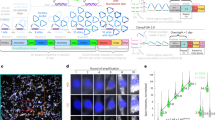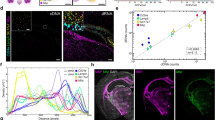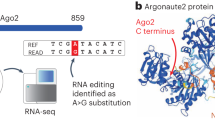Abstract
MicroRNAs are short, noncoding RNA transcripts that post-transcriptionally regulate gene expression. Several hundred microRNA genes have been identified in Caenorhabditis elegans, Drosophila, plants and mammals. MicroRNAs have been linked to developmental processes in C. elegans, plants and humans and to cell growth and apoptosis in Drosophila. A major impediment in the study of microRNA function is the lack of quantitative expression profiling methods. To close this technological gap, we have designed dual-channel microarrays that monitor expression levels of 124 mammalian microRNAs. Using these tools, we observed distinct patterns of expression among adult mouse tissues and embryonic stem cells. Expression profiles of staged embryos demonstrate temporal regulation of a large class of microRNAs, including members of the let-7 family. This microarray technology enables comprehensive investigation of microRNA expression, and furthers our understanding of this class of recently discovered noncoding RNAs.
This is a preview of subscription content, access via your institution
Access options
Subscribe to this journal
Receive 12 print issues and online access
$259.00 per year
only $21.58 per issue
Buy this article
- Purchase on Springer Link
- Instant access to full article PDF
Prices may be subject to local taxes which are calculated during checkout



Similar content being viewed by others
References
Bartel, D.P. MicroRNAs: genomics, biogenesis, mechanism, and function. Cell 116, 281–297 (2004).
Yekta, S., Shih, I.H. & Bartel, D.P. MicroRNA-directed cleavage of HOXB8 mRNA. Science 304, 594–596 (2004).
Doench, J.G., Petersen, C.P. & Sharp, P.A. siRNAs can function as miRNAs. Genes Dev. 17, 438–442 (2003).
Zeng, Y., Yi, R. & Cullen, B.R. MicroRNAs and small interfering RNAs can inhibit mRNA expression by similar mechanisms. Proc. Natl. Acad. Sci. USA 100, 9779–9784 (2003).
Arasu, P., Wightman, B. & Ruvkun, G. Temporal regulation of lin-14 by the antagonistic action of two other heterochronic genes, lin-4 and lin-28. Genes Dev. 5, 1825–1833 (1991).
Reinhart, B.J. et al. The 21-nucleotide let-7 RNA regulates developmental timing in Caenorhabditis elegans. Nature 403, 901–906 (2000).
Vella, M.C., Choi, E.Y., Lin, S.Y., Reinert, K. & Slack, F.J. The C. elegans microRNA let-7 binds to imperfect let-7 complementary sites from the lin-41 3′UTR. Genes Dev. 18, 132–137 (2004).
Chen, C.Z., Li, L., Lodish, H.F. & Bartel, D.P. MicroRNAs modulate hematopoietic lineage differentiation. Science 303, 83–86 (2004).
Aravin, A.A. et al. The small RNA profile during Drosophila melanogaster development. Dev. Cell 5, 337–350 (2003).
Sempere, L.F., Sokol, N.S., Dubrovsky, E.B., Berger, E.M. & Ambros, V. Temporal regulation of microRNA expression in Drosophila melanogaster mediated by hormonal signals and broad-complex gene activity. Dev. Biol. 259, 9–18 (2003).
Lim, L.P. et al. The microRNAs of Caenorhabditis elegans. Genes Dev. 17, 991–1008 (2003).
Sempere, L.F. et al. Expression profiling of mammalian microRNAs uncovers a subset of brain-expressed microRNAs with possible roles in murine and human neuronal differentiation. Genome Biol. 5, R13 (2004).
Krichevsky, A.M., King, K.S., Donahue, C.P., Khrapko, K. & Kosik, K.S. A microRNA array reveals extensive regulation of microRNAs during brain development. RNA 9, 1274–1281 (2003).
Igloi, G.L. Nonradioactive labeling of RNA. Anal. Biochem. 233, 124–129 (1996).
Griffiths-Jones, S. The microRNA Registry. Nucleic Acids Res. 32, D109–D111 (2004).
Quackenbush, J. Microarray data normalization and transformation. Nat. Genet. 32 (Suppl.), 496–501 (2002).
Wang, Y., Lu, J., Lee, R., Gu, Z. & Clarke, R. Iterative normalization of cDNA microarray data. IEEE Trans. Inf. Technol. Biomed. 6, 29–37 (2002).
Eistetter, H.R. A mouse pluripotent embryonal stem cell line stage-specifically regulates expression of homeo-box containing DNA sequences during differentiation in vitro. Eur. J. Cell Biol. 45, 315–321 (1988).
Leahy, A., Xiong, J.W., Kuhnert, F. & Stuhlmann, H. Use of developmental marker genes to define temporal and spatial patterns of differentiation during embryoid body formation. J. Exp. Zool. 284, 67–81 (1999).
Liu, C.G. et al. An oligonucleotide microchip for genome-wide microRNA profiling in human and mouse tissues. Proc. Natl. Acad. Sci. USA 101, 9740–9744 (2004).
Schmittgen, T.D., Jiang, J., Liu, Q. & Yang, L. A high-throughput method to monitor the expression of microRNA precursors. Nucleic Acids Res. 32, e43 (2004).
Meister, G. et al. Human argonaute2 mediates RNA cleavage targeted by miRNAs and siRNAs. Mol. Cell 15, 185–197 (2004).
Houbaviy, H.B., Murray, M.F. & Sharp, P.A. Embryonic stem cell–specific microRNAs. Dev. Cell 5, 351–358 (2003).
Lagos-Quintana, M., Rauhut, R., Lendeckel, W. & Tuschl, T. Identification of novel genes coding for small expressed RNAs. Science 294, 853–858 (2001).
Acknowledgements
Cluster and Treeview software were developed by M. Eisen and generously distributed by Stanford University. The authors acknowledge the UNC Genomics and Microarray Core Facility for assisting in microarray production. The authors thank G. Hannon, Y. Xiong, M. Carmell, and members of the Hammond laboratory for critical reading of the manuscript and discussion of the project. S.M.H. is a General Motors Cancer Research Foundation Scholar.
Author information
Authors and Affiliations
Corresponding author
Ethics declarations
Competing interests
The authors declare no competing financial interests.
Supplementary information
Supplementary Fig. 1
MicroRNA sequences used for microarray design. (PDF 53 kb)
Supplementary Fig. 2
Normalization of microRNA microarrays. (PDF 66 kb)
Rights and permissions
About this article
Cite this article
Thomson, J., Parker, J., Perou, C. et al. A custom microarray platform for analysis of microRNA gene expression. Nat Methods 1, 47–53 (2004). https://doi.org/10.1038/nmeth704
Received:
Accepted:
Published:
Issue Date:
DOI: https://doi.org/10.1038/nmeth704
This article is cited by
-
MicroRNA Expression Profile in Patients Admitted to ICU as Novel and Reliable Approach for Diagnostic and Therapeutic Purposes
Molecular Biotechnology (2023)
-
DISE/6mer seed toxicity-a powerful anti-cancer mechanism with implications for other diseases
Journal of Experimental & Clinical Cancer Research (2021)
-
Single-molecule amplification-free multiplexed detection of circulating microRNA cancer biomarkers from serum
Nature Communications (2021)
-
Highly selective and antifouling electrochemical biosensors for sensitive MicroRNA assaying based on conducting polymer polyaniline functionalized with zwitterionic peptide
Analytical and Bioanalytical Chemistry (2021)
-
Label-free and sensitive MiRNA detection based on turn-on fluorescence of DNA-templated silver nanoclusters coupled with duplex-specific nuclease-assisted signal amplification
Microchimica Acta (2021)



